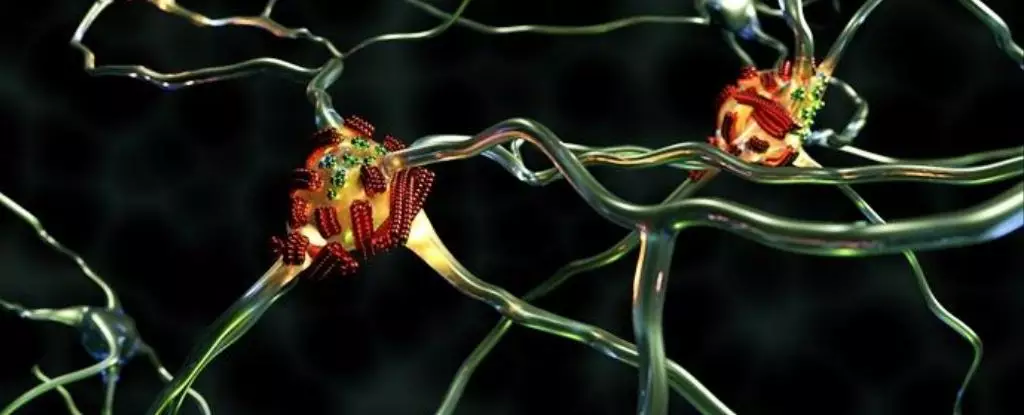Alzheimer’s disease continues to present profound challenges for researchers, healthcare providers, and families touched by its effects. Despite extensive efforts to untangle the intricate mechanisms behind the disease, our understanding remains fragmented. A recent study has illuminated the role of a specific subset of amyloid beta proteins—dubbed ‘superspreaders’—in the progression of Alzheimer’s, sparking renewed intrigue about their implications for disease management and treatment.
The study, spearheaded by molecular physicist Peter Nirmalraj and researchers from the University of Limerick, utilized advanced imaging techniques to scrutinize the behavior of amyloid beta proteins within a salt solution, closely mimicking the brain’s natural environment. This innovative approach diverges from conventional methods, which often inadvertently alter the proteins’ structure and behavior, leading to incomplete or misleading data on their natural states. Nirmalraj’s inquiry into these proteins reveals a particularly alarming trajectory for a subset of amyloid beta that demonstrates a notably high reactivity at their edges.
These proteins’ propensity to intertwine and form long, string-like fibrils raises critical questions about their role in the braiding of amyloid plaques that are characteristic of Alzheimer’s disease. As the presence of these plaques escalates, so too do the cognitive impairments associated with Alzheimer’s, such as memory loss and confusion. However, significant uncertainties remain. Are these clusters fundamentally harmful, or do they merely signify a more complex underlying pathology?
What sets these ‘superspreaders’ apart is their enhanced ability to catalyze the growth of additional amyloid beta proteins, leading to an accelerated accumulation of fibrils. This discovery indicates that a subset of amyloid beta proteins not only contributes to plaque formation but does so with an unprecedented efficiency that could play a pivotal role in Alzheimer’s pathology. The team’s observations identified amyloid beta 42 as a significant player in this fast-tracked aggregation process, arising only after other amyloid beta fibrils have formed.
The implications of this are multifaceted. On one hand, understanding exactly how approximating amyloid beta 42 contributes to pathology could yield valuable insights into potential therapeutic avenues. On the other hand, the study raises additional questions regarding the chemical structure and characteristics that make amyloid beta 42 distinct from other protein variants.
A Need for a Holistic Approach
While this research enhances our understanding of the biochemical landscape of Alzheimer’s disease, it also underscores a pressing reality—the disease’s complexity. The traditional view of amyloid beta proteins as the sole culprits behind Alzheimer’s is rapidly evolving. A growing body of literature suggests that neurodegeneration is influenced by an array of factors that include but aren’t limited to amyloid plaques.
For instance, while amyloid beta accumulation has been closely monitored, the potential impact of other associated molecules that interact with these proteins remains markedly under-explored. Some researchers posit that examining Alzheimer’s through the lens of autoimmune responses may uncover new pathways and strategies for intervention.
The multifactorial nature of Alzheimer’s exposure highlights the necessity for interdisciplinary approaches that can integrate genetic, molecular, and systemic perspectives. To cultivate treatments that truly address the nuances of this disease, researchers must engage in concerted efforts to delineate the respective roles of various biological actors involved in Alzheimer’s pathology.
In sum, this study on amyloid beta ‘superspreaders’ marks a promising excrescence in the field of Alzheimer’s research. It highlights the importance of advanced imaging techniques in understanding protein dynamics within the brain, ultimately elucidating the relationship between the accumulation of these proteins and the manifestation of cognitive decline. Yet, as we stand on the precipice of potential breakthroughs, one must exercise caution. The complexity of neurodegenerative diseases necessitates continued exploration beyond the realm of amyloid beta alone, forging pathways to a comprehensive understanding and more effective treatments. Advancing our grasp of neurological disorders demands an openness to novel ideas and a commitment to exploring the myriad factors contributing to their emergence and progression. As researchers persist in their endeavors, crucial insights into Alzheimer’s may very well unfold, offering hope to millions impacted by this relentless condition.


Leave a Reply